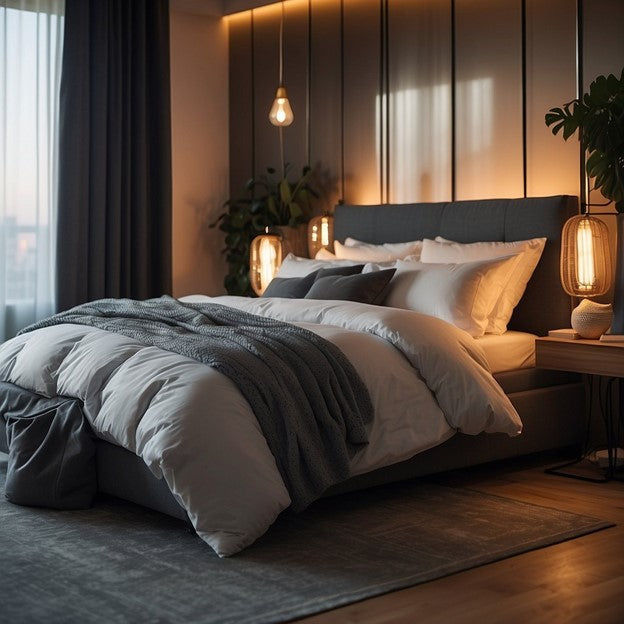Your Cart is Empty
Have you ever wondered what goes inside a duvet cover? You may think it's just a simple blanket, but there's actually more to it than that. The best duvet covers are essentially a protective layer that goes over a duvet insert to keep it clean and add some style to your bedding.

For duvet covers, the most common filling is down, made from the soft feathers of ducks or geese, offering excellent insulation and breathability for a warm yet lightweight cover. Alternatively, synthetic fibers like polyester are also popular. In this quick read, we’ll guide you through duvet covers, setup tips, and care advice.

Understanding the best duvet covers involves knowing the various materials available, such as cotton, linen, and microfiber. Each material offers different benefits, like breathability, durability, and ease of maintenance. By selecting the right duvet cover, you can enhance your comfort and add a stylish touch to your bedroom decor.
The finest duvet covers come in a variety of styles and designs to suit your personal preferences and aesthetics. Some popular types of duvet covers include solid colors, patterns, prints, and luxurious designs.
The material of your duvet cover can greatly affect its comfort and durability. Common materials include cotton, linen, polyester, wool, and silk. Cotton is a popular choice for its softness and breathability, while high-quality linen duvet covers are known for their durability and natural texture. Meanwhile, polyester is a budget-friendly option that is easy to care for, while wool and silk provide luxurious comfort and warmth.
To ensure the proper sizing and fit of your duvet cover, it is important to measure your comforter and choose a cover that matches its dimensions. Most duvet covers come in standard sizes such as twin, full, queen, and king. However, it is important to check the specific measurements of each cover to ensure a proper fit.

Setting up your linen duvet cover starts with choosing the right size to fit your duvet insert. Next, lay the cover inside out on your bed, align the corners of the insert with the cover, and secure them together. Finally, turn the cover right side out, shake it to distribute the insert evenly, and smooth it out for a crisp, finished look. Here's a more comprehensive way to get started:

To do this, lay the duvet cover flat on your bed with the opening at the foot of the bed. Then, lay your duvet on top of the cover, making sure it is evenly distributed. If your duvet cover has corner ties, tie them to the corners of your duvet to keep it in place. If your cover doesn't have corner ties, you can use safety pins to secure the duvet to the cover.
Once your duvet is in place, it's time to secure the cover. If your duvet cover has buttons, simply button it up. If it has a zipper, zip it up to keep the duvet inside. Some covers also have lace closures, which can be tied together to secure the duvet. Snaps are another type of closure that can be found on some duvet covers. If your cover has snaps, simply snap them together to secure the duvet.
Keep your best duvet cover set looking its best by taking proper care of it. Most duvet covers are machine washable; check the care instructions before washing. If machine washable, wash it in cold water and tumble dry on low heat; if not, have it dry cleaned.
Use a stain remover or spot cleaner to remove stains from your duvet cover, testing any cleaning products on a small, inconspicuous area first to avoid damage.
Keep your duvet cover wrinkle-free by ironing it on a low setting or hanging it up to dry after washing to smooth out any wrinkles.
Duvets are filled with either down, synthetic fibers, or wool to provide warmth and comfort inside a duvet cover. Choosing the right duvet insert enhances your sleep experience and complements your bedroom decor. Explore our duvet cover collections today to find the perfect match for your bedding needs!
Yes, you do! A duvet cover is like a giant pillowcase that goes over your duvet insert. It keeps your duvet clean and protected, and also adds a decorative touch to your bed.
The thing that goes inside a duvet cover is called a duvet insert. It's also sometimes called a comforter insert or a duvet filler.
Duvet covers are not actually filled with anything - they are just a cover for your duvet insert. However, duvet inserts can be filled with a variety of materials, such as down feathers, synthetic fibers, or a blend of both.
The kind of insert you put in a duvet cover depends on your personal preferences and needs. Down feathers are a popular choice for their warmth and softness. Meanwhile, synthetic fibers can be a good alternative for those with allergies or who prefer a vegan option.
Make sure to choose an insert that is the same size as your duvet cover for the best fit.
